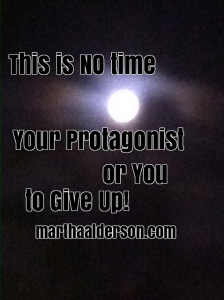As you approach the three quarter mark of your story, do not succumb to a personal crisis as your protagonist reaches her darkest moment. You’re beginning to doubt yourself? Evoke the emotion you’re feeling in your writing. Your story feels a mess? Use your feelings to bring depth to your protagonists emotions. Everyday brings new challenges until you’re ready to give up? This is what your protagonist should be feeling. You wonder what’s the point? Thanksgiving is calling you out of your writing cave? All to often, this is when this is when a writer quits, discontinues, abandons the story. You’ve heard the expression — the darkest hour is just before the dawn. This is exactly where you are as things seem at their worst. In just days they’ll get better. This is no time for your protagonist or you to give up.
what your protagonist should be feeling. You wonder what’s the point? Thanksgiving is calling you out of your writing cave? All to often, this is when this is when a writer quits, discontinues, abandons the story. You’ve heard the expression — the darkest hour is just before the dawn. This is exactly where you are as things seem at their worst. In just days they’ll get better. This is no time for your protagonist or you to give up.
The Crisis
To satisfy the Universal Story, the crisis and scene of highest intensity so far in the story generally hits around three-quarters into the entire page count, give or take a breath or two or three. This is the spot in your story where the energy of the story rises to a breaking point.
The energy in the story coalesces and explodes at the crisis. Sometimes the highest point in the story so far functions primarily on an external dramatic action level. The action at the crisis always reveals more about the protagonist’s internal makeup and emotional maturity.
A story is about a character transforming her weaknesses into strengths. Plot Whisperer Tweet: The protagonist’s fears, flaws, and strengths make her believable and represent challenges she must overcome if she’s to transform.
Two Separate Scenes
Sometimes the crisis takes the form of two separate events written in two separate scenes. In this case, one scene hits the highest point so far in the story for the dramatic action plot crisis. Then the scene moves even higher and a reflects the character’s emotional development plot dark night. Possibly the character emotional development crisis comes first and the dramatic action crisis follows. Generally, these two high points occur near each other for maximum effect. Though they also can occur separately and fall further apart.
Character Transformation
Major Antagonists
The main character faces many antagonists throughout the story — anything or anyone who stands in the way of your protagonist achieving her goal is considered an antagonist. In every scene the protagonist has a goal she believes takes her another step nearer to her desired goal. Every scene has some sort of direct or indirect conflict, tension, suspense or uncertainty which comes from whatever or whomever stands in the way of her moving forward.
Some antagonists and obstacles come and go — the weather, a time limit, a family member. Some antagonists continue throughout the entire story with the protagonist. A story does not require that you have a physical antagonist with a face and a name and a past. And, yes, many protagonists are riddled with an internal antagonist that does more harm than any external interference. However, by creating an external antagonist(s), you afford yourself more opportunities to develop excitement in the exotic world of the middle (the antagonist’s world).
The Protagonist’s Crisis is the Antagonist’s Climax
Antagonists create subplots in the middle and help create the tension and conflict that leads up to the antagonist climax which serves as the protagonist’s crisis (around the 3/4 mark in your story).
Antagonist(s) demand the same attention to detail in development as your protagonist.


Follow Me!